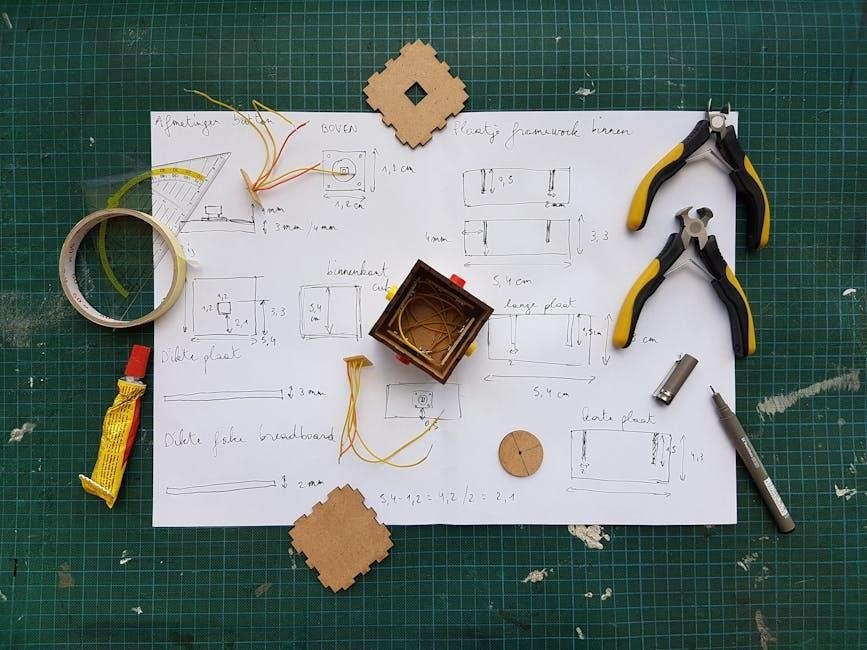
permaculture a designers manual
Permaculture, rooted in sustainable design, offers a framework for creating self-sufficient ecosystems, blending ecological principles with practical strategies to enhance biodiversity and meet human needs effectively.
1.1 Definition and Evolution of Permaculture
Permaculture, a design philosophy rooted in sustainability, mimics natural ecosystems to create self-sufficient human habitats. Initially defined by Bill Mollison and David Holmgren as an alternative to industrial agriculture, it has evolved into a holistic approach blending ecology, ethics, and practical design. The term combines “permanent agriculture” and “permanent culture,” emphasizing long-term stability. Over time, permaculture expanded beyond farming to encompass community building, urban planning, and regenerative practices. Its core idea is to design systems that work with nature, enhancing biodiversity while meeting human needs. This evolution reflects a growing recognition of its potential to address global environmental and social challenges, making it a cornerstone of modern sustainability efforts.
1.2 Key Ethics of Permaculture
Permaculture is guided by three core ethics: Earth Care, People Care, and Fair Share. Earth Care emphasizes stewardship of the planet, preserving biodiversity, and ensuring ecosystems thrive. People Care focuses on meeting human needs sustainably, fostering community well-being, and promoting social justice. Fair Share encourages resource distribution, ensuring surplus benefits others and reinvests in the system. These ethics form the moral foundation of permaculture, inspiring designs that prioritize sustainability, equity, and regeneration. By aligning human activities with nature’s principles, these ethics aim to create resilient, inclusive, and ecologically harmonious systems for future generations.
1.3 Importance of Permaculture in Modern Sustainability
Permaculture plays a vital role in addressing modern sustainability challenges, offering practical solutions to climate change, food insecurity, and resource depletion. By mimicking natural ecosystems, it promotes regenerative practices that enhance biodiversity, improve soil health, and conserve water. This approach fosters resilience, enabling communities to adapt to environmental uncertainties while ensuring long-term food sovereignty. Permaculture’s emphasis on renewable resources, waste reduction, and eco-friendly design aligns with global sustainability goals. Its holistic methodology encourages integrated land use, reducing reliance on industrial systems and empowering individuals to contribute positively to Earth’s well-being. As a design philosophy, permaculture inspires innovative, community-driven solutions that prioritize ecological balance and human well-being, making it indispensable in the pursuit of a sustainable future.

Core Principles of Permaculture Design
Permaculture design is guided by ethical principles that promote harmony with nature, efficient resource use, and self-regulating systems, ensuring sustainable and productive ecosystems for all living beings.
2.1 Observing and Interacting with Nature
Observing and interacting with nature is the foundation of permaculture design. By carefully studying ecosystems, designers can mimic natural patterns, ensuring systems are efficient and resilient. This principle encourages deep observation of land, climate, and biodiversity to understand how elements interact. It promotes working with nature rather than against it, fostering symbiotic relationships between plants, animals, and people. Techniques like noting microclimates, soil types, and water flows help designers make informed decisions. This approach minimizes external inputs and enhances ecological balance, creating systems that thrive over time. Observation also teaches patience, as natural processes often unfold slowly, guiding designers to adopt long-term, adaptive strategies.
2.2 Catch and Store Energy
Catch and store energy is a core principle of permaculture, emphasizing the importance of capturing and conserving resources to maximize efficiency. This involves identifying and harnessing available energy flows, such as water, sunlight, and organic matter, to meet system needs. Techniques like water harvesting (e.g., swales, ponds), energy-efficient technologies (e.g., solar, wind), and nutrient cycling (e.g., composting) are commonly used. By storing energy in various forms, such as soil organic matter or batteries, systems become more resilient and less dependent on external inputs. This principle encourages passive energy use and long-term sustainability, ensuring resources are used wisely and wasted minimally. It aligns with nature’s cycles, where energy is stored and released naturally, promoting regenerative and self-sustaining ecosystems. Efficient energy management is key to a productive permaculture design.
2.3 Obtain a Yield
Obtaining a yield ensures that permaculture systems are productive and provide tangible benefits. This principle encourages designing systems where every element serves a purpose and contributes to the overall productivity. It emphasizes the importance of harvesting resources sustainably, such as food, energy, or materials, while maintaining system health. Yields can be immediate, like crops, or long-term, like improved soil fertility. Diversifying yields reduces dependency on a single output, enhancing resilience. For example, a fruit tree provides fruit, shade, and habitat for pollinators. This principle promotes efficiency and discourages underutilized elements, ensuring that efforts are rewarded with abundant and varied returns. It aligns with nature’s abundance, encouraging humans to be active participants in productive ecosystems. Proper planning and design are crucial to maximize yields.
2.4 Apply Self-Regulation and Accept Feedback
Self-regulation and feedback are critical in permaculture, allowing systems to adapt and evolve. This principle involves observing how elements interact and responding to their needs. By embracing feedback, designers can identify imbalances and make adjustments to improve efficiency. For example, pest outbreaks may indicate a lack of biodiversity, prompting the introduction of natural predators. Self-regulation encourages systems to operate cyclically, reducing waste and enhancing resilience. It also fosters a mindset of continuous improvement, where every challenge offers an opportunity to learn and refine designs. This approach ensures that permaculture systems remain dynamic, sustainable, and aligned with nature’s inherent patterns, leading to long-term productivity and harmony.
2.5 Use and Value Renewable Resources
Using and valuing renewable resources is a cornerstone of permaculture, emphasizing the importance of harnessing natural resources that can be replenished over time. This principle encourages designers to prioritize solar, wind, and water energy over finite fossil fuels. By integrating renewable resources, systems become more resilient and less dependent on external inputs. For instance, rainwater harvesting and biofuels like biodiesel are promoted to reduce reliance on non-renewable energy. This approach not only minimizes environmental impact but also fosters sustainable living by utilizing locally available resources. Valuing renewables ensures long-term viability, supports biodiversity, and aligns with nature’s cycles, making permaculture systems inherently eco-friendly and regenerative.
2.6 Produce No Waste
Producing no waste is a fundamental principle of permaculture, aiming to create closed-loop systems where all materials are valued and reused; This approach eliminates the concept of waste by ensuring every byproduct is repurposed. For example, kitchen scraps are composted to fertilize plants, and graywater is recycled for irrigation. This principle encourages designers to think creatively about resource management, transforming potential waste into valuable inputs. By mimicking nature’s efficiency, where nothing goes unused, permaculture systems minimize environmental harm and promote sustainability. This ethos fosters a mindset of abundance, where resources are cycled continuously, reducing the need for external inputs and enhancing overall system resilience.

2.7 Design From Patterns to Details
Designing from patterns to details involves observing and mimicking natural systems to create efficient and sustainable designs. This principle begins with broad, overall patterns, such as land use zones or water flow, before focusing on specific details like plant placement or infrastructure. By understanding how elements interact at different scales, designers can ensure harmony and productivity. For example, identifying natural drainage patterns helps in placing water-harvesting systems effectively. This approach minimizes waste and maximizes efficiency, as each component is integrated thoughtfully. Starting with the big picture allows for a cohesive and functional design that aligns with nature’s inherent order, fostering long-term sustainability and resilience in permaculture systems.
2.8 Integrate Rather Than Segregate
In permaculture, the principle of “Integrate Rather Than Segregate” emphasizes creating interconnected systems where components work together harmoniously. By combining plants, animals, and structures in a way that they support each other, designers can build more efficient and sustainable environments. For instance, integrating nitrogen-fixing plants with crops enhances soil fertility, while animals can contribute to pest control and nutrient cycling. This holistic approach fosters biodiversity and reduces reliance on external resources, leading to a more resilient and productive system. Additionally, integrating water harvesting systems with irrigation needs ensures optimal water use. Ultimately, integration allows for the creation of mutually beneficial relationships, where each element thrives and contributes to the whole, aligning with nature’s interconnected patterns and promoting ecological balance.
2.9 Use Slow and Small Solutions
The principle of “Use Slow and Small Solutions” in permaculture advocates for prioritizing small-scale, low-input approaches that align with natural processes. By utilizing locally available resources and minimizing external dependencies, designs become more sustainable and adaptable. Small systems are easier to manage, require less energy, and allow for more precise observations and adjustments. This approach reduces the risk of overwhelming failures and fosters resilience. It also encourages creativity and resourcefulness, often leading to innovative solutions. Slow solutions, such as relying on natural regeneration rather than rapid monoculture growth, ensure long-term stability and biodiversity. This principle promotes a patient and mindful approach, aligning human efforts with nature’s rhythms and fostering enduring, ecologically harmonious systems.

The Permaculture Design Process
The permaculture design process involves assessing the site, creating a sustainable plan, and implementing eco-friendly practices to harmonize human needs with nature, ensuring long-term productivity and resilience.
The permaculture design framework provides a structured approach to creating sustainable systems by integrating ecological principles with practical design strategies. It begins with site assessment, mapping, and goal setting to align human needs with natural ecosystems. The framework emphasizes holistic planning, considering soil, water, plants, and animals as interconnected elements. By applying the three key ethics—Earth Care, People Care, and Fair Share—the design process ensures a balanced and regenerative system. This step-by-step methodology guides practitioners to evaluate resources, identify patterns, and implement solutions that enhance biodiversity and productivity. The framework is adaptable, making it suitable for various scales, from small gardens to large farms, ensuring long-term resilience and sustainability.
3.2 Analysis: Design by Listing Characteristics of Components
In permaculture design, analyzing components involves listing their characteristics to understand their roles and interactions within the system. This step requires identifying the functions, needs, products, and lifecycle of each element, such as plants, animals, and infrastructure. By evaluating these attributes, designers can determine how components can support or depend on one another. For example, a chicken coop might provide manure for fertilizer while needing food and shelter. This method ensures efficient integration and minimizes waste. It also helps designers anticipate challenges and opportunities, leading to more resilient and productive systems. The goal is to create a harmonious and self-sustaining web of relationships. This analytical approach is both practical and systematic.
3.3 Observation: Design by Observing Natural Patterns
Observation in permaculture involves carefully studying natural patterns and processes to inform design decisions. By mimicking nature, designers create systems that are efficient and resilient. This includes analyzing landforms, water flows, and vegetation zones to determine optimal placements for elements like plants, water bodies, and structures. For instance, observing how water naturally flows across a landscape can guide the placement of ponds or swales. Similarly, noting microclimates helps in positioning plants according to their light and temperature needs. Observation also reveals how ecosystems cycle nutrients and manage waste, inspiring designs that replicate these cycles. This approach reduces the need for external inputs and fosters biodiversity. Over time, observation becomes a continuous process, refining the system for greater harmony with nature. It ensures sustainability and minimizes human intervention.
3.4 Implementation and Maintenance Strategies
Effective implementation and maintenance are crucial for the success of a permaculture system. The process begins with a phased approach, starting small and gradually scaling up to ensure stability. Prioritizing local and renewable resources minimizes costs and environmental impact. Maintenance involves regular observation, adaptation, and repair to sustain ecosystem health. Techniques like mulching, composting, and crop rotation are used to build soil fertility and biodiversity. Integrating animals and plants ensures a balanced system, reducing pests and diseases. Over time, maintenance becomes less intensive as the system matures and self-regulates. Continuous learning and adaptation are key to addressing challenges and optimizing yields. This approach ensures long-term productivity and resilience, aligning with permaculture’s goal of creating sustainable ecosystems. Regular monitoring and adjustments are vital to achieving these outcomes.

Techniques and Strategies
Permaculture employs diverse techniques to create regenerative systems, including soil conservation, water harvesting, agroforestry, polycultures, and integrating animals. These strategies emphasize efficient resource use and biodiversity.
4.1 Soil Management and Conservation
Soil health is the foundation of permaculture systems, ensuring long-term productivity and ecosystem balance. Key strategies include mulching, cover cropping, and incorporating organic matter to enhance soil structure and fertility. Sheet mulching suppresses weeds and retains moisture, while composting recycles nutrients, reducing waste. Conservation tillage minimizes soil disturbance, preserving organic matter and promoting microbial activity. Swales and contour planting prevent erosion on slopes by capturing and storing water. These techniques foster a resilient soil ecosystem, supporting plant growth and biodiversity. Regular monitoring ensures soil health, guiding adaptive management practices. By prioritizing soil conservation, permaculture systems become more sustainable and productive over time.
4.2 Water Harvesting and Management
Effective water management is critical in permaculture, ensuring resources are used efficiently and sustainably. Techniques like rainwater harvesting involve collecting and storing precipitation for irrigation and other uses. Swales, shallow ditches on contour, capture and infiltrate water, reducing runoff and replenishing groundwater. Mulching and cover cropping enhance soil’s water-holding capacity, while greywater systems recycle household wastewater for irrigation. Strategically designing ponds and dams helps store water for seasonal needs. Permaculture emphasizes decentralized water solutions, ensuring resilience during droughts and floods. These practices promote water conservation, reduce reliance on external systems, and create self-sustaining ecosystems. By integrating these methods, permaculture designs maximize water efficiency, supporting biodiversity and productivity.
4.3 Agroforestry Practices
Agroforestry integrates trees into farming systems, enhancing productivity and ecological balance. It mimics natural ecosystems, promoting biodiversity and efficient resource use; Practices include multistory cropping, where trees, shrubs, and crops occupy different vertical layers, maximizing space and resources. Alley cropping involves growing crops between tree rows, improving soil health and reducing erosion. Trees provide shade, improve soil fertility through leaf litter, and create habitats for beneficial insects. Silvopasture systems combine trees with livestock grazing, offering shade and forage while sequestering carbon. Agroforestry reduces reliance on external inputs, enhances resilience to climate change, and increases overall system efficiency. By integrating trees, permaculture designs create diverse, productive, and sustainable landscapes. This approach is vital for regenerative agriculture, ensuring long-term ecosystem health and productivity.

4.4 Polycultures and Companion Planting
Polycultures involve growing multiple crops together to mimic diverse ecosystems, enhancing resilience and productivity. This practice reduces reliance on external inputs and fosters mutual benefits among plants. Companion planting strategically pairs species to deter pests, improve growth, and increase yields. For example, planting marigolds with tomatoes repels nematodes, while beans and corn benefit from mutual support. Polycultures promote soil health by utilizing different root depths and nutrient requirements. They also attract pollinators and beneficial insects, creating a balanced ecosystem. This approach minimizes pest and disease outbreaks by breaking monoculture patterns. By designing polycultures, permaculture systems achieve higher biodiversity and efficiency, ensuring sustainable and abundant harvests. This method aligns with permaculture’s core principle of working with nature.
4.5 Integrating Animals into the System
Integrating animals into permaculture systems enhances biodiversity and productivity while providing essential resources like eggs, meat, and manure. Animals contribute to nutrient cycling, pest control, and soil fertility. Chickens, for instance, control pests and fertilize soil, while larger animals like cows or goats can be used for grazing and manure production; Aquatic animals, such as fish in ponds, further diversify yields. The choice of animals depends on the system’s scale and needs. Their integration must align with the ecosystem’s capacity to avoid overgrazing or resource depletion. Rotational grazing is a key strategy to maintain soil health and prevent overexploitation. This practice ensures sustainable and efficient use of resources, supporting the overall permaculture goal of regenerative living.

Case Studies and Examples
This section highlights diverse permaculture projects, showcasing successful implementations worldwide, from urban gardens to broadacre farms, illustrating sustainable and regenerative practices in action.
5.1 Successful Permaculture Farms and Their Designs
Successful permaculture farms exemplify sustainable design, integrating diverse systems to enhance biodiversity and productivity. These farms often feature zone planning, where elements like vegetable gardens, orchards, and livestock are strategically placed to maximize efficiency. Water management systems, such as swales and ponds, are central to these designs, ensuring resource conservation. Polycultures and agroforestry practices are widely adopted to mimic natural ecosystems, reducing pests and diseases while boosting yields. Notable examples include the Daintree Rainforest in Australia and the Greening the Desert project in Jordan, showcasing how permaculture can thrive in various climates. These farms demonstrate the power of regenerative agriculture, proving that small-scale, eco-friendly systems can be highly productive and resilient.
5.2 Urban Permaculture Projects
Urban permaculture projects demonstrate the adaptability of permaculture principles in city environments. These initiatives often involve rooftop gardens, vertical gardens, and community plots, transforming urban spaces into productive ecosystems. Projects like the Seattle Urban Farm in the U.S. showcase how intensive gardening and food forests can thrive in limited spaces. In Australia, the Urban Permaculture Guild promotes backyard food systems and shared knowledge. These projects highlight the potential for sustainable living in cities, reducing reliance on industrial agriculture while fostering community engagement. They also address urban challenges like food insecurity and pollution, proving that permaculture can flourish in even the most unexpected settings. Such initiatives inspire city dwellers to adopt eco-friendly practices, creating greener, more resilient urban landscapes.
5.3 Small-Scale vs. Large-Scale Permaculture Systems
Permaculture systems vary in scale, from small backyard plots to extensive commercial farms. Small-scale systems focus on self-reliance and efficiency, often serving individual households or communities. They emphasize intensive gardening, minimal resource use, and biodiversity. Large-scale systems, however, aim for broader productivity and economic viability, integrating diverse enterprises like agroforestry and livestock. While small-scale systems are easier to manage and require fewer resources, large-scale systems offer opportunities for significant food production and ecosystem restoration. Both scales share permaculture principles but differ in implementation and impact. Small-scale systems are ideal for urban or limited spaces, while large-scale systems suit rural areas and commercial purposes. Each scale has unique benefits, proving permaculture’s versatility in addressing different needs and environments.

Modern Applications and Innovations
Modern permaculture integrates regenerative agriculture, urban farming, and climate-smart practices; Innovations include agroecology, digital design tools, and renewable energy solutions, enhancing sustainability and scalability globally.
6.1 Permaculture in Climate Change Mitigation

Permaculture plays a vital role in addressing climate change by promoting regenerative practices that enhance ecosystem resilience. Through carbon sequestration in soils, agroforestry, and biodiversity conservation, permaculture designs help mitigate greenhouse gas emissions. Strategies like mulching, cover cropping, and no-till farming improve soil health, increasing its capacity to store carbon. Water harvesting and efficient irrigation systems adapt to changing rainfall patterns, ensuring resource availability during droughts. Additionally, permaculture encourages the use of climate-resilient plant species and polycultures, reducing vulnerability to extreme weather events. By fostering ecological balance, permaculture not only combats climate change but also supports food security and sustainable livelihoods, making it a critical tool for climate action.

6.2 Integrating Technology with Permaculture
The integration of technology with permaculture enhances the efficiency and scalability of sustainable designs. Tools like IoT sensors for soil and water monitoring optimize resource management, while Geographic Information Systems (GIS) aid in precise land mapping and pattern analysis. Renewable energy systems, such as solar and biogas, power permaculture operations sustainably. Digital platforms facilitate knowledge sharing, enabling global collaboration among practitioners. Automation in irrigation and crop monitoring reduces labor and improves yields. Such innovations complement permaculture’s ecological principles, ensuring modern solutions align with its ethical framework. By blending traditional wisdom with cutting-edge technology, permaculture becomes more accessible and effective in addressing contemporary challenges. This synergy drives sustainable development while preserving natural systems.
6.3 Permaculture in Economic Development
Permaculture plays a vital role in economic development by fostering sustainable livelihoods and resilient communities. By promoting local food systems, it reduces reliance on industrial agriculture, enhancing food security and supporting small-scale farmers. Permaculture designs often integrate diverse crops and animal systems, increasing yields and income streams. Local economies benefit from the creation of value-added products, such as preserves and crafts, derived from permaculture outputs. Additionally, permaculture projects create jobs in sectors like organic farming, agroforestry, and eco-tourism. This approach encourages entrepreneurship, empowering individuals and communities to become self-sufficient. By prioritizing resource efficiency and biodiversity, permaculture contributes to long-term economic stability, making it a cornerstone of sustainable development strategies.
Permaculture offers a sustainable future by integrating regenerative practices, fostering ecological balance, and empowering communities globally. Its principles ensure resilience, biodiversity, and abundant resources for generations to come.
7.1 The Role of Permaculture in Sustainable Futures
Permaculture plays a pivotal role in shaping sustainable futures by promoting ecological balance and regenerative living. It empowers individuals and communities to design systems that work with nature, ensuring biodiversity, resource efficiency, and climate resilience. By integrating permaculture principles into agriculture, urban planning, and daily life, societies can address environmental challenges while improving food security and economic stability. Its focus on long-term sustainability makes it a cornerstone for creating thriving ecosystems and communities. As global awareness of environmental issues grows, permaculture offers practical solutions to mitigate climate change, conserve resources, and foster a healthier planet for future generations. Its holistic approach ensures a pathway toward a more sustainable and equitable world.
7.2 Challenges and Opportunities for Permaculture
Permaculture faces challenges such as limited awareness, scalability issues, and initial implementation costs, which can hinder its widespread adoption. Additionally, regulatory barriers and skepticism from conventional agricultural sectors often pose obstacles. However, these challenges also present opportunities for growth and innovation. Educating communities about permaculture’s benefits can drive adoption, while technological advancements can enhance scalability. Collaboration with governments and organizations can address policy and funding limitations. The rising demand for sustainable solutions creates a fertile ground for permaculture to thrive. By addressing these challenges, permaculture can expand its reach and contribute more effectively to global sustainability efforts, offering a promising pathway for ecological and social transformation. This duality underscores its potential to reshape the future of agriculture and beyond.




